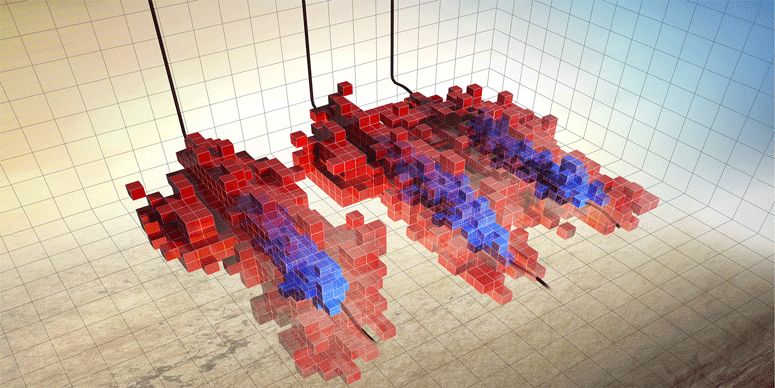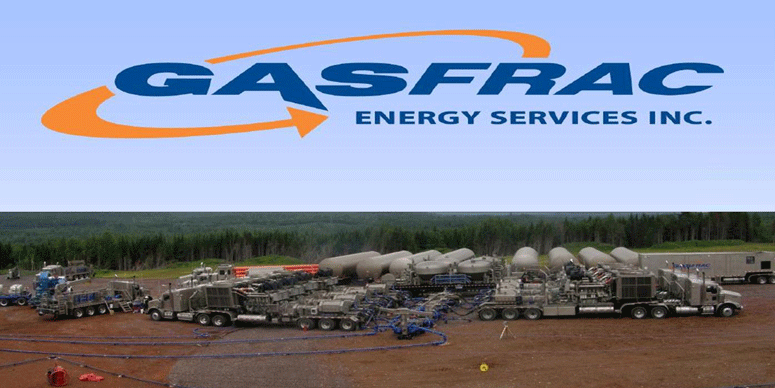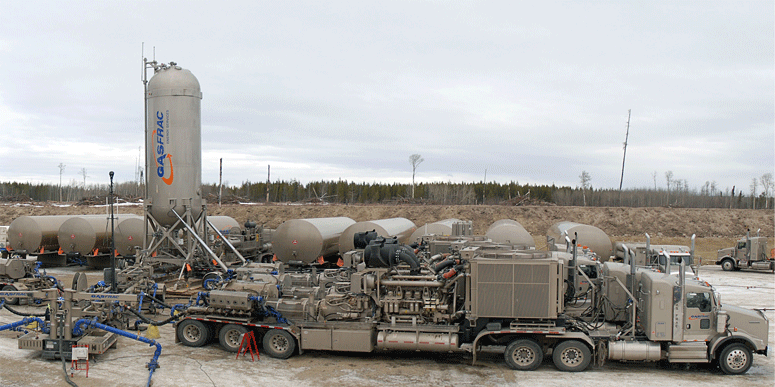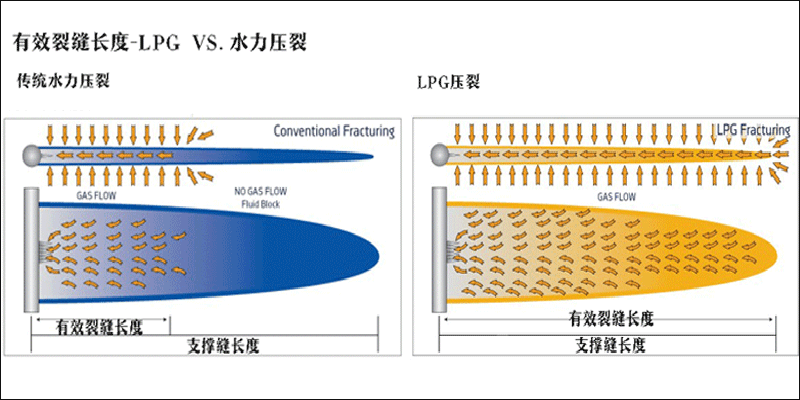Arkansas, Colorado, Texas—all states of the historic western frontier. Conjuring up images of sprawling ranches, longhorn cattle, and cowboys, the relationship between the American west and the farming industry has endured for almost 200 years. However, modern reality in the form of the race for shale gas, is quickly catching up. As perpetually dry western states close in on a third year of drought and record breaking heat waves, the hydraulic fracturing industry is quickly out-competing ranchers in the scramble for increasingly limited water resources.
‘We’re not going to be able to raise the food we need,’ said Ben Rainbolt, executive director of the Rocky Mountain Farmers Union. ‘How are we going to produce this with less?’1
As cries of protest from environmental and farming groups are on the rise, a new technology developed by GasFrac of Canada has the potential to make such concerns obsolete. Liquid propane gas fracking, or LPG fracking, completely eliminates the need for water in fracking processes, leading inventor Robert Lestz to believe that the technology could have “a substantially game-changing impact on industry”2.
What is LP gas fracking?
In the most basic sense, LPG fracking simply involves switching out the working fluid used in the fracturing process. Standard hydraulic fracturing uses an injected fluid made up mainly of water, using an average of 60,000 gallons of water per well5. Water is an effective fracturing fluid because it is functionally incompressible—that is, upon application of high pressure, the surrounding rock will give before the water will. Water was adopted as the standard fracturing fluid because it is comparatively cheap and available, with well known chemical and mechanical properties. However, when it comes to pure functionality, any incompressible fluid will do the job.
Although propane is a gas at room temperature and pressure, with cooling and pressurization, it can exist in a virtually incompressible gel-like phase. As such, LPG fracking uses this propane gel in place of water to both fracture the rock formation and deliver proppant. As in standard hydraulic fracking, the propane gel, or LPG, is mixed with proppant and pumped down the wellbore, seeping into the formation until such high pressures are reached that the rock fractures.
Environmental advantages of LP gas fracking
In the environmental sense, there are two major concerns associated with water use in fracking—the massive volume of water used and the disposal of potentially polluted produced water. LPG fracking is environmentally attractive in that it efficiently addresses both issues.
Most dramatically, LPG fracking is advantageous in that it reduces average water use per frack treatment from 60,000 gallons to zero. However, the LPG process also uses less total fluid volume than standard fracking. According to Lestz
‘Say we want to get oil or gas out of an area of shale about 500 feet long. It would take maybe 20,000 gallons of propane. If I want to do 500 feet with water, I might need 80,000 or 100,000 gallons of water.’2
This reduction in total volume means less transport trucks, smaller drill sites, and lower associated land use and emissions.
In addition, LPG fracking neatly solves the problem of produced water pollution and disposal. Unlike propane, water is a polar, inorganic molecule, making it a ready solvent for underground salts and minerals. As a result, as water makes the trip down a wellbore, into a rock formation, and back again, it may pick up unwanted “passengers” such as seabed salts, heavy metals, and radioactive elements3. While these substances are naturally occurring, they are not usually found on the surface and are potentially harmful to plant and animal life. This polluted water must then be either filtered and treated or disposed of through injection back underground. Conversely, as a non-polar hydrocarbon, propane does not dissolve such substances and will return to the surface unpolluted.
Production advantages of LP gas fracking
In addition to alleviating environmental concerns, LPG fracking may also offer production advantages. When a well is fractured using a water-based fluid, some of that water inevitably remains behind causing “damage” to the formation. That is, the residual water blocks tiny channels in the rock, reducing permeability and inhibiting gas flow8.
Using LPG as a fracking fluid offers an elegant solution to this issue. Propane is pumped down the wellbore in a liquid state under high pressure and low temperature. However, as the fracturing of the rock alleviates pressure, and the liquid begins to heat back up, the propane reverts to a gaseous state. Rather than blocking gas flow, the propane then mixes with the natural gas and they flow up the wellbore in solution. Unlike water, propane and natural gas mix well and have similar flow properties. In fact, propane is often a natural component of natural gas in small concentrations. Upon reaching the surface, the propane can then be separated and sold, rather than incurring treatment and disposal costs like water4.
Economic hurdles for LP gas fracking
Despite the numerous environmental and functional advantages, LPG fracking remains relatively obscure and seen mainly as a niche technology—a viable option for production in water sensitive conditions but not a likely replacement for hydraulic fracturing across the board.
Much of this resistance has to do with the lack of established infrastructure for LPG fracking. Unlike hydraulic fracking, propane gas fracking requires specialized equipment to perform all operations under the pressure and low temperatures needed to keep propane in a liquid state. As propane is also a volatile and flammable material, a barrage of monitoring devices and safety equipment is necessary to minimize operating risks. These tools are expensive to buy, build, and run.
At the same time, the infrastructure needed for hydraulic operations is widely available and ubiquitous across the oil and gas industry.
‘The infrastructure is already there for water, people have already put millions into it,’ Lestz said, ‘Sometimes the good is the enemy of the great.’
With GasFrac fracturing its first LPG well in 2008, the technology is also dauntingly new and untested3. Much more documented experimentation and detailed research will be necessary in order to inspire the confidence that significant investment demands.
‘This is a very conservative industry,’ said David Burnett, an engineering professor at Texas A&M University, ‘Engineers want to see what someone else did first, and they want the data.’3
As the GasFrac process is a proprietary technology owned by a small company, this initial data may be hard to come by.
The GasFrac process
LPG fracking was developed by research engineer Robert Lestz as an offshoot of work he was doing for Chevron in the 1990s2. Originally experimenting with liquid nitrogen and carbon dioxide, the idea for using propane was sparked one night when his wife reminded him to “turn off the gas grill”2. Lestz took the idea and ran with it, eventually developing the pressurized, closed loop system that was adopted by the Canadian start-up GasFrac in 2006.
As the company has developed, with Lestz as its chief technology officer, the process has been refined and patented in the US and Canada. Elaborate safety equipment and procedures have also been added to deal with the volatile fluid, including a vapor and pressure sensor system, infrared cameras, complete remote equipment operation, and emergency gas release flares.
‘It’s well known in the oil and gas industry that the earliest adoption of new technologies is typically on the Canadian market. In Canada, just about every oil and gas company sits on the same block in downtown Calgary, and they’re much more in tune with what their neighbors are doing. Everybody is scratching and clawing for a competitive advantage.’ (Lestz)
Since used LPG technology to frack its first well in 2008, GasFrac has performed 1,863 fractures of 657 locations as of spring 2013.

 石油圈
石油圈



